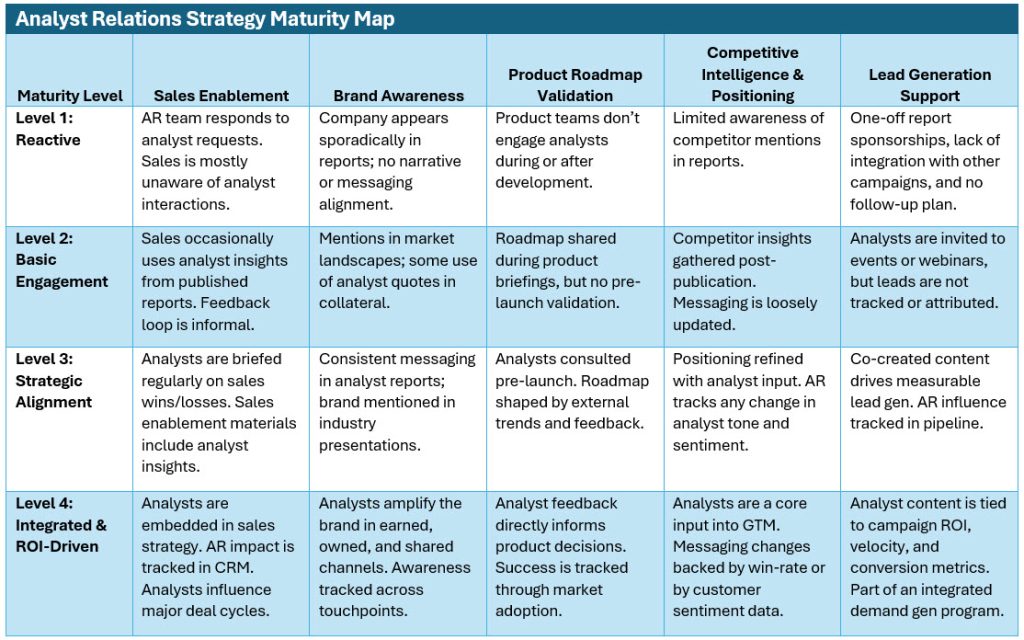An analyst relations (AR) program can be a powerful business asset. It can influence market perception, shape product decisions, and help sales win deals. But one truth stands above all: an AR strategy is not “one size fits all.” Picking the right program depends on several factors. One is your organization’s level of AR maturity.
Those who are new to analyst relations might find interest in reading this article, Understanding Industry Analyst Relations: Definition, History, and Impact.
Every organization must build its AR program from its own perspective. That means aligning it to your unique goals, budget, and current maturity level. A strategy that works for a fast-growing startup might fail in a multinational enterprise. The challenge is understanding where you are now and what steps will deliver the greatest value next.
The first step is recognizing that a strong AR strategy must be designed and implemented based on several internal factors, including:
- Business goals – Is the priority to accelerate sales cycles, boost brand recognition, validate the product roadmap, or improve market positioning? Of course, all of these are important, but it is important to rank these objectives, as sufficient budget may not exist to effectively accomplish each one.
- Budget and resources – How many people can support AR, and what budget is available for analyst engagements and content? Paying for an analyst advisory agreement is just the tip of the iceberg to what the total investment might be.
- Product maturity – Are you pre-launch, scaling rapidly, or maintaining a mature portfolio that needs continued analyst attention?
- Market competition – Are you in an emerging category that analysts are still defining, or a crowded one where differentiation is difficult?
- Current analyst perceptions – Are analysts aware of your company? Do they have outdated or inaccurate views that need correcting? Fixing a bad impression is much harder than introducing a new one.
When you understand these inputs, you can craft a program that fits your situation instead of copying another company’s playbook.
Why AR Maturity Matters
AR maturity reflects how integrated your analyst relations program is as part of your broader business. It’s not about the number of analyst briefings you hold – it’s about how strategically AR supports sales, marketing, product, and competitive intelligence.
Organizations with higher AR maturity tend to see greater ROI from their programs. They can influence the analyst community’s understanding of the market, and in turn, the level that analysts will influence buyers, investors, and media. But before you can move to a higher level, you need to know where you stand today.
That’s where the below Analyst Relations Strategy Maturity Map comes in. Taking a cue from the analysts I have worked with in the past, this concept is a helpful one in driving an effective strategy.
Analyst Relations Strategy Maturity Map
This map organizes AR maturity into four levels, each building on the last. It looks at five categories or attributes of a program: Sales Enablement, Brand Awareness, Product Roadmap Validation, Competitive Intelligence & Positioning, and Lead Generation Support.

How to Use This Map
Assess Your Current Level
Look at each of the five categories. Place your organization at the level that best reflects your current approach.
Spot Gaps
You might be at Level 3 for Sales Enablement but Level 1 for Product Roadmap Validation. This uneven maturity is common.
Define Your Next Step
Focus on moving up one level in your weakest areas. The next level gives a clear picture of what’s needed.
Tie to Business Goals
Improvements should connect directly to objectives such as revenue influence, brand visibility, or launch success. That ensures AR investments are justified.
Track Progress Quarterly
Revisit your maturity assessment every quarter. This keeps AR on the agenda and ensures continuous improvement.
Moving from Level 1 to Level 2
Let’s say your AR team currently responds only to inbound analyst requests. Analysts may not even know your full product offering. In this case, your next step could be:
- Schedule quarterly proactive analyst briefings.
- Share recent customer wins with analysts who cover your market.
- Start a basic tracking system for analyst mentions and tone.
- Ask marketing to include analyst quotes in at least one campaign asset.
These are low-cost, manageable actions that build credibility and set the stage for deeper engagement.
Moving from Level 2 to Level 3
If you already share updates with analysts but lack structured integration, focus on:
- Creating formal sales enablement assets that include analyst insights.
- Holding pre-launch roadmap review calls with key analysts.
- Tracking competitive mentions in real time and updating positioning accordingly.
- Partnering with analysts to produce content designed for measurable lead generation.
This shift requires more coordination across teams, but it can dramatically increase AR’s business impact.
Moving from Level 3 to Level 4
At Level 3, AR is strategically aligned with sales, marketing, and product teams. The next leap is making AR fully integrated and ROI-driven. This requires deeper measurement, tighter collaboration, and embedding analysts into core business processes.
Key steps might include:
- Integrate AR touchpoints into your CRM so sales can see analyst influence on specific deals.
- Involve analysts in major deal cycles where their endorsement could sway buying decisions.
- Track analyst-driven awareness across earned, owned, and shared channels, not just in reports.
- Tie analyst feedback directly to product success metrics like adoption rates or feature usage.
- Use analyst insights as a primary input into go-to-market strategy, with changes backed by win-rate or sentiment data.
- Connect analyst content to campaign ROI, lead velocity, and conversion metrics as part of integrated demand generation.
This level demands not only stronger processes but also a culture where AR is seen as a business driver, not just a communications function. It’s about proving influence in hard numbers and making analysts an embedded partner in achieving strategic outcomes.
AR Maturity Is Not Always Linear
Some organizations jump levels in certain categories due to unique circumstances. For example, a startup might integrate analyst feedback into its roadmap early but have little brand awareness. Others may have strong analyst-driven content for marketing but no formal process for sharing insights with sales.
The goal is not perfection in every area at once. The goal is consistent progress toward a program that is both strategic and measurable.
Why Experience Matters in AR Maturity Assessment
An experienced AR professional knows how to apply the maturity map without creating unnecessary complexity. They can identify the quickest wins and the highest ROI opportunities.
They also understand that each organization’s maturity path is unique. A company in a high-growth market with aggressive launch goals will need a very different plan from a legacy enterprise looking to reposition itself.
A skilled AR leader can:
- Benchmark your program against peers in your industry.
- Recommend actions that match your budget and resource capacity.
- Anticipate how analysts will react to your strategy.
- Build metrics that show leadership the value AR delivers.
This expertise can save months of trial and error. It also ensures that the program advances in a way that aligns with business priorities and market dynamics.
Next Steps
An effective analyst relations program starts with understanding your own AR maturity. The Analyst Relations Strategy Maturity Map provides a clear framework for that assessment. By pinpointing your current level across Sales Enablement, Brand Awareness, Product Roadmap Validation, Competitive Intelligence, and Lead Generation Support, you can set realistic goals and track progress over time.
The most successful programs are tailored, not copied. They fit the company’s stage of growth, competitive landscape, and budget. They also evolve as the organization’s needs change.
Working with an experienced AR professional can accelerate that evolution. The right partner can help you define and execute a plan that advances maturity, maximizes analyst impact, and delivers measurable business results.
If your goal is to get the highest ROI from your AR program, there’s no substitute for expertise. With the right strategy, the right steps, and the right guidance, analyst relations can become one of your most valuable competitive advantages.
If you are interested in discussing this topic in greater detail, perhaps my analyst relations services could be of interest.
